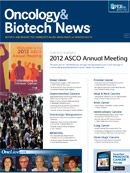Chemoradiation Established as New Standard in Glioma Subtypes
A study that unfolded over 17 years has established combination chemotherapy after radiotherapy as a new standard of care for patients with anaplastic oligodendroglial tumors that contain 1p/19q chromosomal co-deletions.
Martin J. Van Den Bent, MD
A study that unfolded over 17 years has established combination chemotherapy after radiotherapy (RT) as a new standard of care for patients with anaplastic oligodendroglial tumors that contain 1p/19q chromosomal co-deletions.
The European Organisation for Research and Treatment of Cancer (EORTC) launched the EORTC 26951 study before the chromosomal mutation was defined, and the results represent a persistent effort to apply emerging science to treatment of the rare tumor type, researchers said in discussing the findings.1
The phase III trial enrolled 368 patients with newly diagnosed, previously untreated anaplastic oligodendroglial tumors, a grade III type of diffuse glioma that has a typical survival rate ranging from 3 years to >7 years. Specifically, study participants had the histological subtypes of oligodendroglioma and oligoastrocytoma, which account for approximately 5% to 10% of all diffuse gliomas.
By the mid-1990s, when the study began, researchers had discovered that patients with recurrent gliomas of these types were sensitive to PCV chemotherapy, a regimen consisting of procarbazine, CCNU (lomustine), and vincristine, lead author Martin J. Van Den Bent, MD, said in presenting results at a press conference and at a plenary session at ASCO 2012.
Previously, the standard had been aggressive surgery followed by RT. Under the current standard, most patients currently receive either chemotherapy or RT, but not both.
“The study was set up as a classical adjuvant chemotherapy study in gliomas,” said Van Den Bent, who is a professor of Neuro-Oncology at the Erasmus MC-Daniel den Hoed Cancer Center in Rotterdam, the Netherlands.
Patients were randomized to receive either RT (59.4 Gy) followed by six cycles of PCV or the same RT alone. He said patients in the RT group were permitted to cross over at progression. “We are looking at a trial comparing early chemotherapy versus delayed chemotherapy,” he said.
The study was amended in 2001 to perform an exploratory analysis for the 1p/19q codeletion, which was characterized in 1998, and results were further examined after the significance of MGMT methylation in RT/temozolomide chemotherapy, and then the IDH mutation in gliomas were defined.
Long-term follow-up results demonstrated that patients who received RT followed by PCV chemotherapy experienced overall survival (OS) of 42.3 months compared with 30.6 months for those who received RT alone. Progression-free survival was 24.3 months in the RT/PCV group versus 13.2 months in the RT group.
An analysis of the genetic subtype of the original participants indicated that the positive results stemmed mostly from a subset of 80 patients with the 1p/19q co-deletion, Van Den Bent said.
Among these patients, the RT/PCV treatment reduced the risk of death by 44% compared with those who received RT alone (HR = 0.56). After nearly 12 years’ follow-up, the median OS for those in the combination group has not yet been reached, while those with the co-deletions who received RT alone had an OS of 9 years. By contrast, there was no statistically significant benefit for the addition of PCV in patients without the co-deletion.
In addition, there was a “very clear trend” toward more benefit in patients with the codeletion, as well as MGMT and IDH mutations, who received adjuvant PCV chemotherapy, indicated Van Den Bent, adding that further study with a larger cohort is needed.
“
Together these studies make the new standard of care for these patients radiation therapy plus PCV chemotherapy.”
—Martin J. Van Den Bent, MD
Van Den Bent said the findings are confirmed by the Radiation Therapy Oncology Group (RTOG) study 9402, another long-term study presented at the conference.2 “Together these studies make the new standard of care for these patients radiation therapy plus PCV chemotherapy,” he said.
Among the questions that emerge from the studies are the optimal treatment sequence, whether temozolomide should be the chemotherapy choice, and future treatments for patients in other molecular subtypes, said Van Den Bent.
Bruce J. Roth, MD
Bruce J. Roth, MD, a genitourinary medical oncologist at the Siteman Cancer Center at Washington University in St. Louis, Missouri, who moderated the press conference where the results were discussed, said the significance of EORTC 26951 extends beyond the malignancy studied.
“This will be an important trial, not because it’s a rare tumor type, but because it provides a model for identifying patients with a specific genomic signature who may or may not benefit from a particular type of intervention— as it’s clearly the direction that therapy is headed,” he said.
Mark R. Gilbert, MD, the discussant at the oral presentation, said the study reaffirms the importance of prospective tumor collection in clinical trials and of going beyond histological findings.
“We have reached this conclusion only after an extensive period of time and a major effort on the parts of both cooperative groups to increase tumor acquisition and follow-up on the outcome data,” said Gilbert, a professor in the department of Neuro-Oncology at The University of Texas MD Anderson Cancer Center in Houston. “It does, in fact, underscore the importance of perseverance in data and tumor collection.”
Photos by © ASCO/Scott Morgan 2012
- Van Den Bent MJ, Hoang-Xuan K, Brandes AA, et al. Long-term follow-up results of EORTC 26951: A randomized phase III study on adjuvant PCV chemotherapy in anaplastic oligodendroglial tumors (AOD). J Clin Oncol. 2012;30(suppl; abstr 2).
- Cairncross JG, Wang M, Shaw EG, et al. Chemotherapy plus radiotherapy (CT-RT) versus RT alone for patients with anaplastic oligodendroglioma: Long-term results of the RTOG 9402 phase III study. J Clin Oncol. 2012;30(suppl; abstr 2008b).




